 Birth certificate with no name yet April 17, 1888; 215 West 45th St.
NY,NY
Birth certificate with no name yet April 17, 1888; 215 West 45th St.
NY,NY
 Baptism certificate of Adelia September 15, 1888
Baptism certificate of Adelia September 15, 1888
Mary Pyle "Maria l'Americana"
Adelia Maria McAlpin Pyle for more than four decades was a fixture at San
Giovanni Rotondo.[1]
Born at her parents’ town house in Manhattan,[2]
[3] she was from a wealthy Protestant and
socially prominent family.[4]
 Birth certificate with no name yet April 17, 1888; 215 West 45th St.
NY,NY
Birth certificate with no name yet April 17, 1888; 215 West 45th St.
NY,NY
 Baptism certificate of Adelia September 15, 1888
Baptism certificate of Adelia September 15, 1888
Baptized at the Church of the Covenant, a Presbyterian church of which her
mother was member.[5]
Later she was instructed in the Catholic faith while in Spain by a Jesuit
Father. She was conditionally baptized again. The ceremony was performed by a
Capuchin friar, and she assumed the baptismal name of Maria.[6]
Maria was fluent in Italian, Spanish and German. In 1912 she met the educator
Maria Montessori and become her interpreter.
[7]
In 1923 Maria and her friend Rina d’Ergin Caterinici has spent the summer in
Capri with Maria Montessori. Rina asked Maria to accompany her to San Giovanni
Rotondo. On October 2, 1923, they left Capri, sailed to Naples, took a train to
Foggia, and a bus to San Giovanni Rotondo.[8]
 Mary Pyle (standing far right in the picture) with Maria
Montessori (far left, with her son), in a Montessori school in New York City, at
the Panama Pacific Exposition.
Mary Pyle (standing far right in the picture) with Maria
Montessori (far left, with her son), in a Montessori school in New York City, at
the Panama Pacific Exposition.
Born only a year after Padre Pio, her origins were in total contrast to Padre
Pio’s humble and poor beginnings.[9]
She wrote about the first encounter with Padre Pio: “We just looked at each
other at first, then I fell to my knees and said :’Father’. He placed his
wounded hand on my head and said: ‘My child, stop travelling around. Stay here.”[10]
Mary returned briefly to Montessori, and after accompanying her to Holland and
England, she went back to Padre Pio with Montessori. When they were about to
leave she cried out: “I can’t. I feel paralyzed, as though someone had nailed my
feet to the ground.” So Montessori took the bus for Rome alone, and had Mary’s
possessions sent to her.[11]
The two women never again met or spoke.[12]
Maria went to San Giovanni Rotondo armed with six languages, a musical education
and a great love of music, years of study in the best of American private
schools, well-travelled, accustomed from childhood to every luxury.[13]
She joined the Third Order of St. Francis in a ceremony led by Padre Pio on
September 6, 1925.[14]
She obtained permission to wear the
habit of the Order.[15]
She even slept in her habit.”[16]
At first she rented a room with a family named Vinciguerra, about two miles down
the road from the convent.[17]
[18]
She went to the friary each morning for Mass and stay there during the day with
other women devotees of Padre Pio, having bag lunch at noon, sitting on a small
stone wall that surrounded an elm tree.[19]
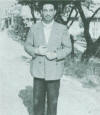
 Pietruccio Cugino, blind since chilhood, with Padre
Pio.
Pietruccio Cugino, blind since chilhood, with Padre
Pio.
Frequently Mary shared her lunch under the elm tree with Pietruccio, the child
of a poor local family who would spend his day in the convent and visiting with
Padre Pio. Later Pietruccio, still a young age got retinitis pigmentosa and
became blind. He began to lose his sight when he was twelve. By teenage he was
totally blind. Sometimes Mary sent question and got answers from Padre Pio
through Pietruccio. [20]
The people in town called her “Maria l’Americana”, ‘Mary the American’, at first
with suspicion, but later, with reverence and affection.[21]
When Maria’s brother, David, a successful attorney, learned of her whereabouts,
he came to see her. He was horrified that she was betraying her social class by
living in what he considered an unutterable squalor. He reported it to Adelaide,
their mother.[22]
Adelaide came to San Giovanni Rotondo, became fast friends with Padre Pio, and
visited frequently from Rome, where she had an apartment. She reinstated her
daughter’s allowance, sending her tremendous sums of money for that time and
place.[23]
Maria was able to construct a three story house near the convent. People called
it the pink castle.[24]
When the building was completed, around 1927, Padre Pio, who could not walk well
on his wounded feet, rode a donkey down the hill in order to bless it.
[25]
![]()


 Outside
of Mary Pyle's villa, with the original mail box of he Italian mail.
Outside
of Mary Pyle's villa, with the original mail box of he Italian mail.
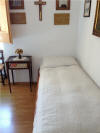
 Pictures of the inside of Mary Pile's home in San Giovanni
Rotondo.
Pictures of the inside of Mary Pile's home in San Giovanni
Rotondo.
On the ground floor of the house was a large room which served all purposes.
There was a long refectory table, and anyone who wandered in was always welcome
to share a simple meal. At this table she sat to write letters for the poor
illiterate women of San Giovanni Rotondo, she played tombola and other games
with the youngsters who came up on foot from the town two miles below, to be
catechized as well as entertained. Also, and most frequently of all, girls went
there to practice singing and learn hymns, grouper around the small harmonium
that formed part of the furnishing.
[26]
No one who knocked on her door for assistance was ever turned away. Mary had a
large brown book were some of the visitors wrote their names. Many visitor of
every class, from Europe and America, passed by, including famous people.[27]
During the WWII many American GI’s were recipients of her hospitality.[28]
In her home she made hosts for the Masses and held choir practices.
[29]
Adelaide went back frequently to San Giovanni Rotondo. Maria was concerned that
she did not convert from Baptism to Catholicism. Padre Pio said: “Let her be.
Don’t upset her peace. She will be saved because she has faith.”[30]
On the last Adelaide’s visit to Padre Pio, shortly before she died, he said:
“Let’s hope we meet again, but if we don’t see each other here, we will see each
other up there.”[31]
On day Maria Pyle asked Padre Pio: “Can I build a convent in Pietrelcina?” Padre
Pio: “Do it at once and let it be dedicated to the Holy Family.”
![]() Padre Pio was in Via Gregaria with don Salvatore Pannullo
whe he said the that one day a church and convent would be built there.
Padre Pio was in Via Gregaria with don Salvatore Pannullo
whe he said the that one day a church and convent would be built there.
With the help of her mother, Maria paid for the construction not only of the
convent, but also of a seminary in Pietrelcina. The building was erected on the
spot indicated by Archpriest Pannullo, were Padre Pio fifteen years earlier had
indicated that a convent would rise.
[32]
The actual work on the convent in Pietrelcina began in 1926. The first stones
were brought by the enthusiasts townspeople, removed from the crumbling old
chapel known as Purgatory church. In only one day all the stones were
transported to the new site and a mound of stones several yards high loomed in
the twilight. As evening fell, another portent appeared. A great light, in the
form of an immense cross was seen over the pile of stones. It gradually rose up
from the top of the pile and appeared over Pietrelcina. The cross was seen for
about half an hour, as it slowly climbed over the sky and eventually
disappeared.[33]
Maria moved to Pietrelcina during the construction.[34]
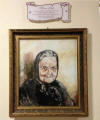 Painting of Mary Pyle in the sacristy of the church. The
sign above the painting is in gratitude for her extreme generosity.
Painting of Mary Pyle in the sacristy of the church. The
sign above the painting is in gratitude for her extreme generosity.
In a little over two years the convent was completed, but due to many
difficulties, it would be another twenty years before it would actually be
occupied by the Capuchins.[35]
Only in April 1947 the first Capuchins arrived to the convent.[36]
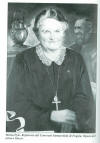 Painting of Mary Pyle in the Capuchin convent in Foggia.
Painting of Mary Pyle in the Capuchin convent in Foggia.
Construction of the adjoining Holy Family church began in 1928. During the
construction the problem of lack of water came up. Padre Pio was informed, and
described a location were the laborers should dig. To everyone’s amazement a
large spring was found there. So the construction continued.[37]
[38]

 Stained window (made in Vietri) in the Holy Family church depicting Mary Pyle
donating the church to Padre Pio.
Stained window (made in Vietri) in the Holy Family church depicting Mary Pyle
donating the church to Padre Pio.
In early December 1928, on one of her return trips to San Giovanni Rotondo from
Pietrelcina, Maria Pyle had been accompanied by Padre Pio’s mother Giuseppa, as
she wanted spend Christmas with her son. She stayed at Maria’s home. When
Giuseppa met Padre Pio she kissed his hand about ten times, for each of her
family members. When she tried to kiss his hand for herself, Padre Pio refused,
saying: “Never! The son should kiss the hand of the mother, not the mother the
hand of the son.”[39]
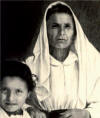 Mamma Peppa with her niece Pina.
Mamma Peppa with her niece Pina.
On Christmas Giuseppa “Mamma Peppa” went to the midnight Mass. Back to Maris’s
home she came down with high fever and double pneumonia. Padre Pio came many
times to comfort her, mounted on a mule on the narrow, rocky, dusty path leading
from the convent to Maria’s house.[40]
Padre Pio was asked to pray for her recovery. He replied: “God’s will be done.”
Padre Pio administered the last rites, and she died peacefully on January 3,
1929.[41]
Maria Pile sent a telegram to her mother Adelaide announcing the death of Padre
Pio’s mother. Adelaide replied that Padre Pio had visited her recently in
bilocation. Maria asked Padre Pio if that was true. Padre Pio replied: “I always
go there.”[42]
In 1937 Padre Pio’s father, Grazio, had moved to San Giovanni Rotondo, in the
home of Maria Pyle. On Good Friday 1939 Grazio told Maria that as a form of
devotion the meal had to consist of one plate of “pasta e fagioli” and a glass
of water, and had to be eaten on their knees. There were several guests that
day, and all were moved, and obliged. Grazio said that it was an order from
Padre Pio. The episode was reported to Padre Pio and he said that he had not
said anything. However Padre Pio told his father: “Daddy, you did very well.”[43]
At Maria’s home Zi’ Grazio was frequently at the center of conversation, recalling episodes of the life in Pietrelcina of Francesco, the future Padre Pio.
 In the last few months of life Zi’ Grazio was not able to walk to church to
be at Padre Pio’s Mass, and Maria provided a mule to take him there.
In the last few months of life Zi’ Grazio was not able to walk to church to
be at Padre Pio’s Mass, and Maria provided a mule to take him there.
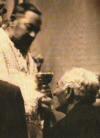 Zi’ Grazio receiving Communion from his son.
Zi’ Grazio receiving Communion from his son.

 When Zi’ Grazio fell ill, Padre Pio went to
visit him every day at Maria’s home. He died on October 7, 1946, comforted by
his son at bedside.[44]
When Zi’ Grazio fell ill, Padre Pio went to
visit him every day at Maria’s home. He died on October 7, 1946, comforted by
his son at bedside.[44]
Later in 1941 America and Italy were at war. Mary Pyle had an American passport. She was summoned to Rome and was accompanied in the trip to the Ministry of Internal Affairs by Padre Emilio da Matrice who could vouch for her character. Instead of being incarcerated, Mary was sentenced to “house arrest” at the home of Padre Pio’s parents. She reached Pietrelcina on December 27, 1941.
 On the right, arched entry to maternal home. A man stands on top of the stairs
leading to Michele's home. It was not inhabited by other people when Mary stayed
in Pietrelcina, occupying a room on the second floor.
On the right, arched entry to maternal home. A man stands on top of the stairs
leading to Michele's home. It was not inhabited by other people when Mary stayed
in Pietrelcina, occupying a room on the second floor.
Mary stayed
in Pietrelcina until October 3, 1943, when, with the Allied troops moving north the
Italian peninsula, the American soldiers reached Pietrelcina. A few days later,
she started the trip back to San Giovanni Rotondo with the help of Davide
Aucone. It took them several days, hoisting her belongings into a farm wagon,
traveling through roads and bridges bombed out. It was a long trek back to San
Giovanni Rotondo.[45]
 Mary receiving Communion from Padre Pio
Mary receiving Communion from Padre Pio
In 1943-5 many GI’s went to San Giovanni Rotondo to meet Padre Pio. All of them would look for the “pink castle’, the home of Mary Pile. She gave them “generous hospitality, preparing meals for them, around her long kitchen table, were twenty people could sit comfortably”, talked to them about “the holy man on the mountain”, and then introduced them to Padre Pio, translated for them, and gave them feedback.
Several of the GI’s gave written recollection of their visits to
San Giovanni Rotondo. Joe De Sanctis, Bob Mohs, Joe Revelas, Ray Ewens, with the
15th Army Air Force in Cerignola. Eugene McMahon, Tony Afflitto, Carl
Amato, Pete Mier of the 463 Bomb Group. Joe Haines, who was with the 416 Bomb
Group. Robert Simmons, Ed Kearns and Rudy Tucci, who were with the 99th
Bomb Group. Leo Fannings and Joe Astarita stationed in Cerignola. John McKenna,
Joe Peluso, Ronald McMillan, Bob Coble, Joe Peterson and many others. Their
stories can be read in the books of Frank Rega[46]
and Bernard Ruffin,[47]
and on the website padrepiodevotions.org in San Diego.
It was Padre Pio who asked Maria to learn to play the old reed organ in the
church.[48]
Maria organized a choir of local ladies which she accompanied as they
sung at the Mass services and at the afternoon benediction.[49]
Padre Pio and the congregation were extremely pleased with the added decorum
provided by the sound of the organ and the choir.[50]
Mary continued to play the organ until Elena Bandini, an accomplished organist,
arrived in San Giovanni Rotondo and replaced her.
[51]
Maria assisted the convent with the foreign correspondence, thought catechism to
local children, and never failed to supply food and money to the sick and needy.[52]
[53]
Clarice Bruno: “I think her really great work was the moral help, encouragement,
and enlightenment she brought into the lives of so many persons in moments of
great darkness, misery, and anguish of all kinds, putting them in contact with
Padre Pio. I spent years in Mary’s Franciscan house, or in her little garden,
listening to her witty a humorous conversation. She would tell anecdote after
anecdote.”[54]
John McCaffery: “She trained the village girls in womanly arts and crafts, and
in womanly dignity. She also helped in their formal education. I never met
anyone who was not impressed by the blend of sweetness and strength that went to
make her personality.”[55]
Over the years she financed the seminary studies of at least ten priests.
[56]
Padre Pio had once told Mary that she would be the first to die and that he
would follow soon after.[57]
Maria died in Casa Sollievo on April 25, 1968. Padre Alessio asked Padre Pio
were she was, and he replied that she was in Purgatory. Later Mary appeared in a
dream to one of her friends and told her that she had entered in Heaven on May
5. Padre Pio, informed about the dream replied: “She was always a good
religious, and the Lord knows how to give a just reward to those who deserve
it.”[58]
“Mary had a life filled with prayer and
penance, simplicity and perseverance. She helped thousands of people in any kind
of tribulation.[59]
Maria “Mary” Pyle rests in the cemetery of San Giovanni Rotondo, in the chapel
of the Capuchin friars, with Zi’
Grazio and Mamma Peppa.
 Currently, part of Mary Pyle's home houses a
Capuchin vocational center.
Currently, part of Mary Pyle's home houses a
Capuchin vocational center.
A mosaic in the crypt of the new San Pio church depicts Mary Pyle greeting Padre
Pio ad the door of Heaven.
Capuano, P. (2012). Con p. Pio: come in una fiaba. Foggia:
Grafiche Grilli.
Clarice, B. (1970). Roads to Padre Pio.
Roma: Citta' Nuova.
Duchess Suzanne, o. S. (1983). Magic of a Mistic.
Stories of Padre Pio. New York: Clarkson N. Potter.
Gaudiose, D. M. (1974). Prophet of the people. A
biography of Padre Pio. New York: Alba House.
McCaffery, J. (1978). Tales of Padre Pio.
Kansas City: Andrews and McMeel.
Rega, F. M. (2005). Padre Pio and America.
Rockford: TAN books.
Ruffin, C. B. (1991). Padre Pio: the true story.
Huntington, Indiana: Our Sunday Visitor, Inc.
[1] Ruf91, 209-10
[2] Rof91, 210
[3] Reg05, 33
[4] Bru70, 75
[5] Ruf91, 210
[6] Reg05, 37
[7] Ruf91, 212
[8] Ruf91, 213
[9] Reg05, 33
[10] Ruf91, 214
[11] Reg05, 69
[12] Ruf91, 214
[13] Bru70, 75
[14] Gau73, 89
[15] Ruf 91,214
[16] Reg05, 77
[17] Ruf91, 214
[18] Reg05, 70
[19] Reg05, 70
[20] Duc83, 81
[21] Ruf91, 214-5
[22] Ruf91, 215
[23] Ruf91, 515
[24] Ruf91, 215
[25] Reg05, 74
[26] Bru70, 76
[27] Gau73, 90
[28] Reg95, 74
[29] Reg05, 75
[30] Ruf 91, 215
[31] Reg05, 73
[32] Ruf91, 216
[33] Reg05, 92
[34] Reg95, 92
[35] Reg95, 92
[36] Reg95, 93
[37] Ruf91, 217
[38] Reg95, 94
[39] Reg95, 95
[40] Bru70, 76-7
[41] Reg05, 94-6
[42] Reg95, 97
[43] Cap12, 115-6
[44] Cap12, 117
[45] Reg05, 114-7
[46] Reg95
[47] Ruf91
[48] Retg05, 77
[49] Gau73, 89-90
[50] Reg05, 78
[51] Reg05, 78
[52] Ruf91, 215
[53] Gau73, 89
[54] Bru70, 77
[55] McC78, 81-2
[56] Ruf91, 216
[57] Reg05, 243
[58] Reg05, 245-7
[59] Bru70, 78